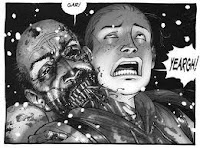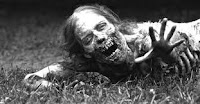I'm not completely backwards. I'll embrace any new technology that I believe genuinely improves my quality of life. I'm much quicker to embrace improvements in audio and video presentation, too, because how could any sane person argue that high definition, lossless audio, and correct aspect ratios aren't improvements. I do not, however, believe that new tech automatically renders old tech obsolete.
Example: I can't stand listening to my home theater receiver attempt to make 5.1 surround sound from an older movie's mono soundtrack. The sound engineers who created that soundtrack created it with the intent of mono playback, and trying to "improve" that soundtrack by spreading it over multiple channels just sounds thin, scattered, and wrong. I'm not a big fan of "better" refresh rate making my shot-on-film-at-24-fps movies look like shot-on-video soap operas, either. Different isn't automatically better.
 |
| the colorized Ymir from 20 Million Miles to Earth |
So how about making a color movie black and white? Well, the same reasoning applies. If the artists who created the work want to see it in black and white, have at it. Black and white presentation still has merits, strengths that color presentation can't duplicate. Particularly with horror movies, the interplay of light and shadow in a black and white presentation can render a focused and dreamlike atmosphere not possible with color. It can also make a newer color movie look more like its cinematic forebears. Witness the black and white version of Frank Darabont's The Mist (2007), for example. Some work benefits from a noirish presentation. Like maybe . . . oh, I don't know . . . The Walking Dead?
 |
| The Walking Dead comic |
 |
| The Walking Dead TV show |
Black and white is a misnomer, anyway. When we say a program is black and white, what we really mean is that we're seeing a continuum of black and white that includes the shades of gray. I suppose the youngsters just prefer not to see things in shades of gray. Sorry, kids, but I'm seeing more and more gray every day. I'm cool with glorious black and white.
Posted by Brandon Early












No comments:
Post a Comment